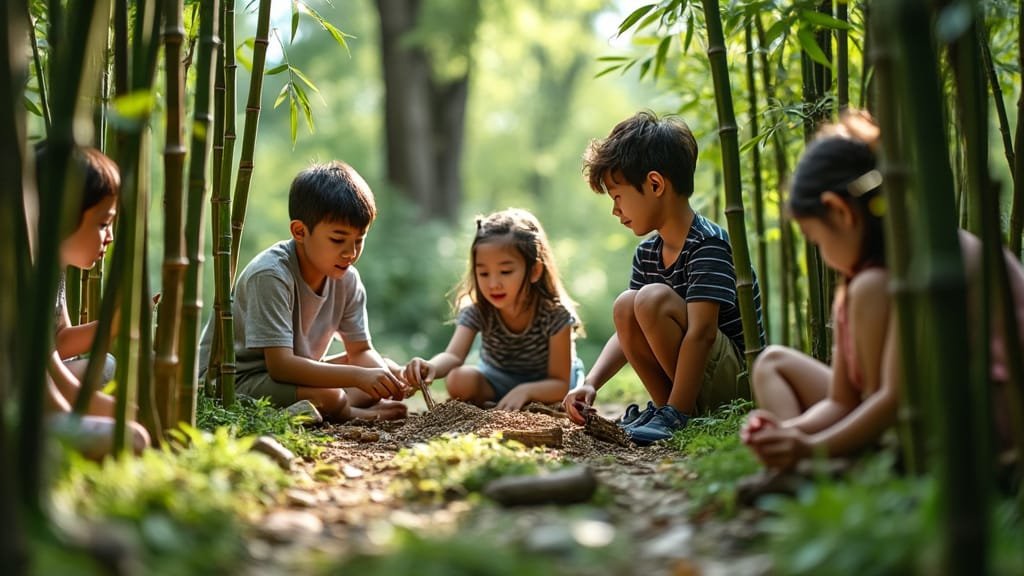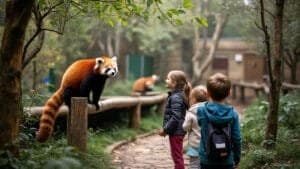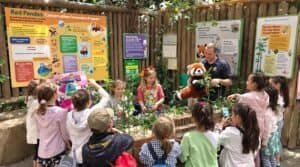Introduction
Red panda-themed workshops and activities have become valuable tools for promoting environmental stewardship, using engaging, hands-on learning to teach conservation principles
These workshops help participants connect with nature by focusing on red panda conservation and sustainable practices. From habitat restoration models to eco-friendly crafts, red panda workshops offer a fun yet impactful way to inspire individuals of all ages to adopt eco-conscious behaviors and support biodiversity protection
This article explores how these activities contribute to environmental awareness, foster sustainable lifestyle habits, and encourage community engagement, helping participants become proactive stewards of the planet
Core Topics in Red Panda-Themed Environmental Workshops
Red panda-themed environmental workshops focus on teaching participants about ecosystems, biodiversity, and the conservation needs of red pandas
These workshops provide information about red pandas’ role in their natural habitat, the importance of protecting endangered species, and how biodiversity supports a healthy planet
Through engaging presentations, interactive discussions, and educational materials, these core topics build a foundation of environmental knowledge and inspire participants to support conservation efforts
Red Panda Habitats and Ecosystem Roles
One of the main topics in red panda-themed workshops is the animal’s native habitat—the Himalayan forests—and the critical role these forests play in supporting biodiversity
Participants learn about the unique plant and animal species that coexist with red pandas and how they collectively contribute to the ecosystem’s health. Instructors explain how red pandas help maintain balance in their habitats by controlling bamboo growth, which affects other species that rely on forest resources
These discussions are often accompanied by visuals, such as maps and photos of Himalayan habitats, making it easier for participants to understand the connection between red pandas and their environment. By exploring the interdependence within ecosystems, workshops encourage participants to consider the broader impact of habitat destruction and climate change on wildlife
Understanding red pandas’ role in their natural habitat helps reinforce the idea that protecting one species contributes to the overall well-being of the ecosystem
Understanding Endangered Species and Threats
Red panda workshops also cover the factors threatening red pandas, such as deforestation, poaching, and climate change, helping participants understand why the species is endangered
Workshop leaders present real-life examples of habitat loss and illegal wildlife trade, explaining how these issues put red pandas at risk. By sharing this information, instructors aim to foster empathy and awareness, encouraging participants to take action against these threats
The workshops may include case studies, statistics, or recent conservation efforts to help illustrate the urgent need for protection. For younger participants, educators often use stories or age-appropriate scenarios that depict red pandas facing various challenges
This approach allows participants of all ages to understand why endangered species protection matters, making it easier for them to relate to the challenges red pandas face
Importance of Biodiversity and Forests
In addition to focusing on red pandas, workshops also emphasize the broader importance of biodiversity and forests
Educators explain how diverse species, like plants, animals, and insects, all contribute to balanced ecosystems, helping to regulate the climate, purify air and water, and support soil health. By teaching participants about biodiversity, workshops highlight how each species—no matter how small—plays a role in sustaining the environment
These discussions often touch on the “ripple effect” of biodiversity loss, explaining that the decline or extinction of one species, such as the red panda, can disrupt other species and even human communities
Workshops may include interactive activities, such as building simple food webs or constructing “mini-forests” to demonstrate how biodiversity supports life on Earth. This awareness helps participants recognize that conservation is not just about saving one species; it’s about preserving the balance of nature as a whole
Hands-On Activities That Encourage Conservation Awareness
Red panda-themed workshops offer a variety of hands-on activities that engage participants and deepen their understanding of conservation principles
These interactive projects allow individuals of all ages to learn about sustainable practices, habitat restoration, and the red panda’s unique ecological needs in fun, memorable ways. By participating in activities like building models, crafting eco-friendly items, and exploring nature, attendees gain practical skills and a greater appreciation for environmental stewardship
Red Panda Habitat Restoration Models
Creating habitat restoration models is a popular activity in red panda workshops, as it allows participants to visualize the elements essential for a thriving red panda habitat
Using materials like clay, recycled items, or natural elements such as leaves and twigs, participants build small-scale replicas of the Himalayan forests where red pandas live. These models typically include features like bamboo clusters, forested areas, and sources of freshwater, illustrating the natural resources red pandas rely on
This hands-on project helps participants understand how habitat degradation—such as deforestation or water pollution—can affect red pandas and other species in their ecosystem
Workshop leaders often discuss real-life habitat restoration projects that focus on reforestation and sustainable practices, showing participants how these actions can make a difference. Building these models empowers attendees to appreciate the significance of habitat preservation, fostering a sense of responsibility toward protecting natural landscapes
Sustainable Crafts and Eco-Friendly Projects
Eco-friendly craft projects are another core activity in red panda workshops, encouraging participants to repurpose materials and think about sustainability in their everyday lives. These projects might include making red panda-themed items like reusable bags, recycled-paper notebooks, or “seed bombs” for planting native plants
Participants are encouraged to use sustainable materials and techniques, learning that small, everyday actions can contribute to environmental protection
Crafts centered on sustainability also provide an opportunity for instructors to discuss waste reduction, recycling, and the environmental impact of single-use plastics. By creating something meaningful and reusable, participants are reminded of the importance of making eco-conscious choices
These activities show that conservation isn’t limited to large-scale efforts but can be practiced at home, encouraging participants to incorporate sustainable habits into their daily lives
Nature Walks and Outdoor Exploration
Many red panda workshops include outdoor activities like nature walks, where participants can observe local ecosystems and learn about native plants and animals. These outings allow attendees to experience natural environments firsthand, helping them connect with nature and understand the importance of preserving habitats for all species
During these walks, instructors often point out elements that red pandas would rely on in their native habitats, such as food sources and tree coverage, making the experience both educational and immersive
Outdoor exploration activities help participants recognize the importance of biodiversity, encouraging them to take an active interest in conservation. By fostering a sense of wonder and appreciation for local flora and fauna, these nature walks inspire participants to become more mindful of the natural world around them
This connection to nature can be a lasting reminder of the role they can play in protecting ecosystems, supporting conservation efforts for red pandas and other species
Promoting Sustainable Lifestyle Habits
Red panda-themed workshops use educational activities to encourage participants to adopt sustainable lifestyle habits that benefit the environment
By focusing on practical steps like recycling, conserving energy, and supporting local habitats, these workshops empower attendees to make eco-friendly choices in their daily lives
The goal is to create a ripple effect, where individual actions inspired by red panda conservation contribute to broader environmental sustainability
Recycling and Waste Reduction Tips
One of the primary ways workshops promote sustainability is through recycling and waste reduction activities. Participants learn about the impact of plastic waste and the importance of reducing, reusing, and recycling materials to minimize environmental harm
Workshop leaders provide actionable tips, such as choosing reusable products, composting organic waste, and avoiding single-use plastics, which can help reduce the overall waste footprint
To make recycling more accessible, some workshops organize hands-on activities where participants repurpose materials into useful or decorative items, like making red panda-themed containers or eco-friendly storage boxes
These activities emphasize the value of reusing resources and encourage participants to continue waste reduction efforts at home, reinforcing that individual actions can have a positive environmental impact
Energy Conservation and Eco-Friendly Choices
Red panda-themed workshops also teach energy conservation practices that support sustainable lifestyles. Participants are introduced to energy-saving tips, like turning off lights and electronics when not in use, using energy-efficient appliances, and choosing renewable energy sources when available
Discussions focus on how reducing energy consumption helps protect natural habitats, including those of red pandas, by reducing greenhouse gas emissions and mitigating climate change
By linking energy conservation with red panda habitat preservation, workshops give participants a personal reason to adopt these habits. Some workshops even offer practical demonstrations, such as using solar-powered devices or comparing energy-efficient products, to show how eco-friendly choices contribute to wildlife conservation
This hands-on approach helps attendees understand that saving energy is not only a cost-effective habit but also a vital part of environmental stewardship
Planting Trees and Protecting Local Habitats
Workshops often encourage participants to engage in local conservation efforts, such as planting native trees and supporting habitat protection in their communities
By learning about the role trees play in red panda habitats—providing food, shelter, and supporting biodiversity—participants gain insight into the ecological benefits of reforestation and habitat conservation
Some workshops even include tree-planting events, where participants can plant saplings in nearby green spaces or parks. These activities give attendees a tangible way to contribute to environmental preservation while connecting with nature on a personal level
For those who cannot plant trees, instructors provide tips on how to support local conservation groups and initiatives, emphasizing that protecting local habitats is a way to support global biodiversity and red panda conservation
Impact on Community Engagement and Environmental Stewardship
Red panda-themed workshops have a positive impact on community engagement, fostering a collective sense of environmental responsibility. By involving local families, schools, and community groups, these workshops create opportunities for people to learn, connect, and work together toward common conservation goals
Through continuous eco-education efforts, red panda workshops contribute to building a community that values and actively participates in environmental stewardship
Involving Local Families and Schools
Workshops that focus on red panda conservation often collaborate with local schools and community centers to reach a diverse audience
Family-friendly events, for example, allow children and parents to participate in eco-activities together, fostering shared experiences and encouraging environmental conversations at home
Schools also benefit from incorporating red panda-themed workshops into their curriculum, where students can explore concepts of biodiversity, conservation, and sustainable practices in a fun, hands-on way
By involving families and schools, these workshops promote environmental stewardship as a community effort rather than an individual task. Attendees learn about red panda conservation while building connections within their communities, creating a network of individuals committed to supporting wildlife protection and sustainable practices
Long-Term Benefits of Eco-Education for Youth
Red panda-themed workshops provide young participants with foundational knowledge and skills that encourage long-term environmental awareness
Studies by Tiwari and Dolma (2021) indicate that eco-education has a lasting impact on youth, instilling values of conservation that influence behaviors into adulthood. By teaching children about red panda conservation through interactive activities, workshops help cultivate a generation of environmentally conscious individuals who are likely to adopt and advocate for sustainable lifestyles
Workshops for young audiences often incorporate games, storytelling, and role-playing activities to make environmental education enjoyable and engaging. By learning through play, children are more likely to retain information about red panda conservation, increasing the likelihood that they will make eco-friendly choices in the future
These lasting benefits highlight the importance of early eco-education, which creates a ripple effect that positively impacts the environment over time
Workshops as Platforms for Conservation Advocacy
Red panda-themed workshops serve as platforms for promoting wider conservation efforts, often providing resources and contacts for participants interested in furthering their involvement
Many workshops distribute informational materials about local conservation initiatives, volunteer opportunities, and ways to support red panda sanctuaries or wildlife organizations. By connecting participants with these resources, workshops empower them to take active roles in conservation advocacy, whether through volunteering, donations, or spreading awareness in their communities
Some workshops partner with conservation organizations to offer follow-up programs, such as nature walks, eco-volunteer days, or advanced conservation classes, which allow participants to deepen their knowledge and involvement
These extended opportunities ensure that red panda workshops continue to inspire and engage participants long after the initial event. By fostering a culture of conservation advocacy, these workshops help build a stronger network of environmental stewards committed to protecting red pandas and their habitats
Conclusion
Red panda-themed workshops and activities play a valuable role in promoting environmental stewardship by educating and inspiring participants of all ages. Through engaging topics like habitat preservation, hands-on conservation activities, and eco-friendly lifestyle practices, these workshops encourage attendees to develop a deep appreciation for wildlife and sustainable practices
By fostering awareness of the red panda’s endangered status and the importance of biodiversity, these workshops empower individuals to adopt sustainable habits and actively contribute to conservation efforts
The community-focused approach of these workshops also strengthens local engagement, bringing families, schools, and community groups together in support of wildlife protection. With long-term eco-education benefits, especially for youth, red panda-themed workshops contribute to building a generation of environmentally conscious citizens who are motivated to protect the planet
As these activities continue to inspire action, they help ensure that conservation becomes a shared responsibility, with participants becoming stewards for both the red panda and the broader natural world









